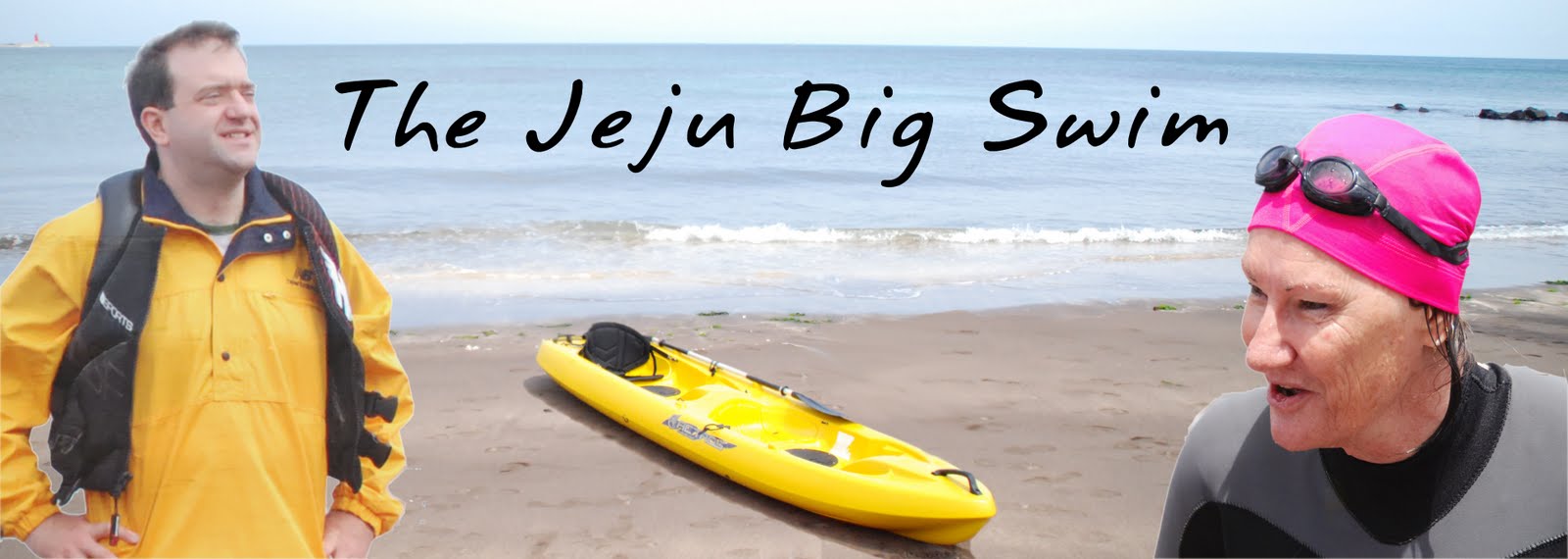While i was swimming around Jeju i wish i had a swim cam. You know - a camera attached to my head so people could see exactly what i could see. If i had such a device the seas might be cleaner than what they are. I knew the sea around Jeju wasn't great; you just have to visit any beach to realise that. Nevertheless, i really wasn't prepared for the reality of what i saw. As i don't have a swim cam, i will just have to tell you.
The water i swam through smelled. And it smelled bad. Sometimes it smelled of sewerage, sometimes it smelled of oil and fuel, and sometimes it smelled of dead rotting fish. In some places it smelled of all those things together, like at Hengwon and at Pyeoson. Rather ironically, the only place where the sea DIDN'T smell bad was near Gangjeong, where the powers-that-be want to build a Naval base. The waters around Gangjeong smelled (and tasted!) like the ocean should - clean, "fresh", and salty.
I swam through a lot of garbage. Sometimes Steve had to call out so i wouldn't swim headlong into a plastic bag or an empty oil container floating in a pile of muck. But what was more disturbing was just how much garbage was under the surface, distributed throughout the water column as far as i could see. In too many places i would look down and see ramyeon bowls, drink cans, ice cream wrappers, cigarette lighters (!), foil and plastic packaging, plastic bottles and bottle caps, plastic forks and spoons, chopsticks and chopstick wrappers. I saw frightening amounts of polystyrene foam, hundreds and hundreds of paper cups, and thousands of plastic bags, in every state of deterioration from whole bags to small fragments. And i saw plastic, plastic and more plastic. I was shocked and saddened to see small schools of fish eating it. Of course they will die.
 |
| Swimming at Hamdeok Beach with plastic bag, can, polystyrene foam and other detritus (Photo Alicia Cabezuda) |
Talking of fish, i didn't see a lot. And what fish i did see were all very small. One effect of overfishing is that the fish in affected areas don't survive long enough to grow into big, healthy breeders. The result is a less resilient fish population that matures younger, is smaller and weaker, and produces fewer eggs. Sad to say, Jeju has over-exploited and very depleted fish stocks.
When you experience Jeju from the sea, as i did, it soon becomes apparent that there is very little of Jeju's "natural" environment left. Evidence of habitat destruction is everywhere. It was very rare to not see a road, a building or a harbour all along the coast.
Pyeoson Beach is representative of the kind of habitat destruction i'm talking about. It is often referred to as "tourism development". If you go there you can see that this area was once an estuary surrounded by sand dunes. Sand dune estuarine areas are home to particularly rich and diverse eco-systems. It has been completely annihilated. The creeks and streams have been built over and are now drains whilst the sand dunes have been flattened to make roads, carparks and picnic areas. All the plants and animals that made up that eco-system are no more.
Probably the most upsetting thing i saw during the whole swim was the way hundreds and hundreds of people picnicking on the grass at Pyeoson made no effort to take their rubbish with them when they left. To get to the beach to swim i had to walk, literally ankle deep, through the previous night's litter - pizza boxes, take away food containers, plastic bags, plastic bottles, broken glass, ramyeon bowls, drink cans, empty cigarette packets, ice cream wrappers, and so on.
It is this mindset and behaviour that The Jeju Big Swim hopes to change.
Sherrin

No comments:
Post a Comment